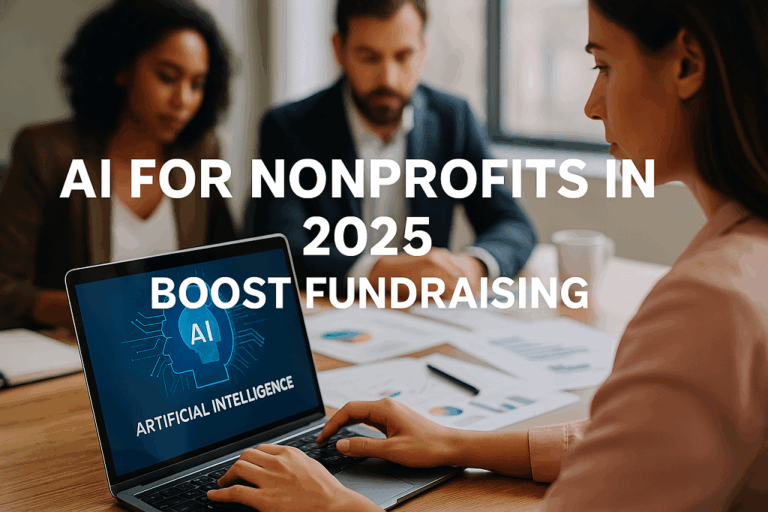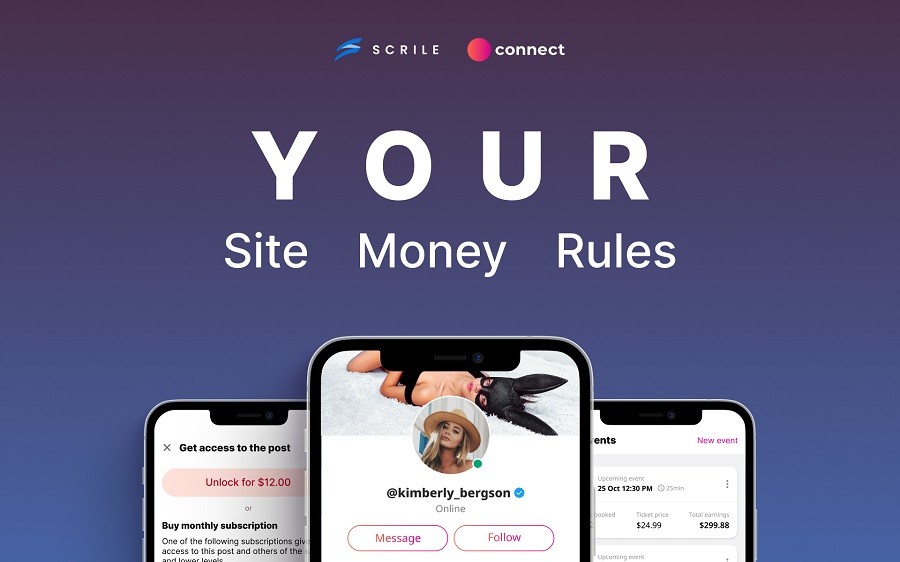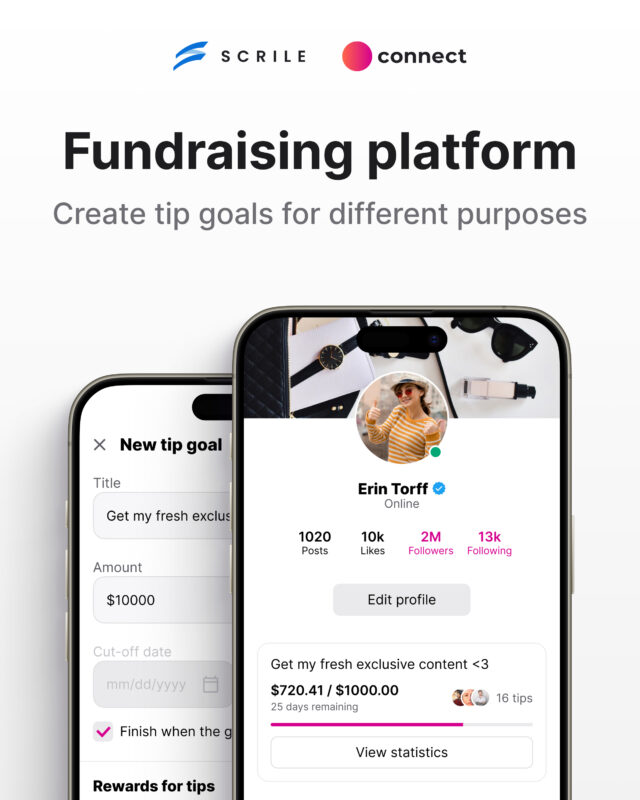AI for Nonprofits in 2025: Boost Fundraising
Discover how to use AI for nonprofits to streamline fundraising, engage donors, and save time. From smart segmentation to personalized campaigns, explore how customizable solutions like Scrile Connect can transform your nonprofit’s strategy in 2025 — without breaking the bank or losing your voice.

ai donor
Most nonprofits are stuck in a loop: always short on time, always chasing funding. There’s never enough staff to follow up with every potential donor. Emails go unopened. Events feel hit-or-miss. And trying to guess who’s actually going to give next month? That’s more luck than strategy. But here’s the shift: AI for nonprofits isn’t some futuristic tool only billion-dollar orgs can afford. It’s here. And it’s rewriting the rules.
Think donor prediction. Smarter segmentation. Chatbots that don’t sound like robots. Personalized campaigns that feel like you actually know the person on the other side. This isn’t about replacing human effort — it’s about amplifying it. Automation where it counts. Insight where you’ve been guessing. Conversations that don’t die in inboxes.
In this article, you’ll get a tour of what’s real (and what’s fluff), who’s already using AI to raise more money with less noise, and what it actually looks like when a nonprofit team puts this tech to work. Spoiler: it’s not a SaaS login screen with one-size-fits-all buttons.
And if you’re serious about keeping your voice, your data, and your donors? We’ll also show why building your own AI-powered setup with Scrile Connect gives you more control than any off-the-shelf tool ever could. Let’s get into it.
What Can AI Actually Do for Nonprofits?

Let’s skip the buzzwords and get down to what matters: what can AI for nonprofits actually do? Not in theory — in practice, on the ground, with the kinds of budgets and teams most organizations actually have.
Real Functions, Not Fantasy
At its core, AI for nonprofits means replacing grunt work with smart automation and making better decisions backed by data — not hunches.
- Donor segmentation and targeting
Instead of treating everyone the same, AI tools divide your audience based on behavior, interests, giving capacity, and engagement history. This means smarter lists, fewer unsubscribes, and better campaign results. According to BWF, AI-based segmentation helped one university reduce outreach by 25% — while increasing donations by 15%. - Smart fundraising chatbots
These aren’t the annoying, generic bots of the past. Think tailored conversations, donation nudges based on prior interactions or helpful info delivered instantly, even after hours. Tools like these turn passive visits into meaningful actions. - Predictive analytics for campaigns
Imagine knowing which donors are most likely to lapse — before it happens. Or identifying high-potential first-time givers who might become long-term supporters. SAP reports that nonprofits using their AI tools saw up to 30% improvement in donor retention. - Admin time reduction
No one signs up to write meeting minutes or summarize documents. AI can now automate these tasks — like Microsoft’s Intelligent Recap, which generates highlights from calls and meetings. More time for strategy. Less for spreadsheets.
Who’s Already Doing It?
A lot of nonprofits think AI is still too “big tech” for them. But real numbers say otherwise. Whether it’s a global brand or a small community organization, the benefits are already showing up in day-to-day work — especially when the right AI tools are applied to the right problem.
SAP, for example, uses AI for nonprofits to track every phase of a donor’s lifecycle — from first interaction to long-term engagement. It’s helped them better understand drop-off points and how to re-engage people before they disappear for good. More insights, fewer lost donors.
At BWF, AI-driven segmentation has changed the game. By using machine learning to analyze giving patterns, demographics, and behavioral data, they’ve increased their campaign ROI by over 22%. It’s not just smarter targeting — it’s smarter everything.
Even local organizations are getting in on it. One small animal charity installed a donor-facing chatbot trained to answer FAQs, send follow-ups, and help with transactions. That alone saved their staff over 10 hours a week in admin time.
And personalization? One education charity tested AI-generated email messaging that adapted tone, length, and timing. The result: a 35% jump in email response rates. They didn’t add more staff — they just gave their outreach a serious upgrade.
Here’s how it looks at a glance:
| Organization | AI Application | Result |
| SAP | Donor lifecycle tracking | Higher retention rate |
| BWF | Predictive outreach, segmentation | Campaign ROI up 22% |
| Local animal NGO | Chatbot donor assistant | 10 hours/week saved in admin |
| Education charity | AI-generated email personalization | +35% email response rate |
This isn’t just Big Tech territory. Yes, companies like SAP are leading the charge — but local nonprofits are also putting AI for nonprofits to work. Real results. Less guesswork. More mission impact.
Key Benefits of AI for Fundraising

If you’ve worked in the nonprofit world long enough, you know the grind: too many donors to engage, not enough time to do it well. That’s where AI for fundraising stops being a buzzword and starts becoming an actual shift in how nonprofit teams operate — faster, leaner, and with way less guesswork.
AI isn’t about replacing people. It’s about making human effort actually count. Instead of emailing 2,000 contacts and hoping 200 respond, AI helps you find the right 200 in the first place. You get better donor segmentation, smarter insights, and a communication strategy that’s driven by data, not instinct.
More Time, Better Results
Let’s start with retention. According to SAP, nonprofits using AI to analyze donor behavior have seen a 25% increase in repeat donations. Why? Because predictive analytics now tell you who’s drifting away — and exactly when to re-engage. That’s huge. A returning donor often gives more over time than a one-time contributor.
On the outreach side, personalization used to mean inserting someone’s name into a newsletter. AI raises the bar. It tracks interests, timing preferences, donation history — and builds tailored messages that feel more one-on-one than mass marketing. You’re not sending more emails. You’re sending smarter ones.
Then there’s the time you win back. Think about the hours your team spends on meeting notes, performance reports, and donor updates. Microsoft’s AI tools have cut admin time by nearly 30% in early pilot programs with nonprofit organizations. That’s not a footnote — that’s someone’s entire workweek back on mission-driven tasks.
And finally, let’s talk about optimization. AI can run A/B tests on subject lines, calls to action, or even donation amounts. But more than that, it learns from those tests and begins to predict which version will work before you even hit send. That means more conversions with less trial and error.
The bottom line? AI for fundraising helps nonprofits do more than keep up — it helps them get ahead. With better timing, deeper insights, and fewer manual tasks, it frees up the one thing every nonprofit desperately needs: focus.
How to Start with AI the Right Way

Jumping into AI sounds exciting — until you’re knee-deep in dashboards with no clue what’s actually helping. Let’s fix that.
Start here:
Step 1: Find the choke points.
Where does your fundraising stall? Is it donor outreach? Retention? Admin overload? Pin that down first — no tool matters if you don’t know the problem.
Step 2: Know your audience.
Map out donor segments. Loyal givers, one-time donors, high-potential newcomers — you can’t automate what you haven’t defined.
Step 3: Pick your path.
Off-the-shelf tools are quick. But custom setups scale better, adapt faster, and keep you in control long-term.
Step 4: Set the ground rules.
Build an AI policy: what you automate, how you protect data, and what donors can expect. Trust matters.
Step 5: Track the right stuff.
Stop measuring everything. Focus on the metrics that move your mission forward.
When it comes to AI and nonprofits, strategy beats tools. The tech’s evolving fast — but clarity, transparency, and intention will always win.
Debunking Myths About AI and Nonprofits

Let’s clear up a few things. First: AI isn’t just for Silicon Valley budgets. Plenty of small organizations are already putting smart tools to work — not with million-dollar grants, but with lean, well-aimed projects. Tools like Scrile Connect make it possible to start where you are, then scale.
Second: You don’t need an IT department to use AI. You need clarity. Who are you reaching? What’s slowing you down? Once that’s defined, the tech can be built around you, not the other way around.
And no, AI doesn’t replace people — it replaces the repetitive stuff. Drafting that third version of a donor email? Covered. Remembering who hasn’t donated since spring? Done. But speaking to your board, thanking your volunteers, showing up with heart — that’s still entirely on you.
The myths are louder than the truth. But with the right partner and a flexible setup, AI for nonprofits is no longer a luxury — it’s a smart next move.
Where Prebuilt Tools Fall Short
You’ve seen the ads: “All-in-one fundraising software,” “Plug-and-play community builders,” “AI made easy.” Sounds great—until you actually try to use them.
Here’s what typically happens. You sign up, get a shiny dashboard, and realize pretty quickly that it wasn’t built for your nonprofit’s real needs. The features are either too rigid or too generic. Worse, they’re often designed around the developer’s roadmap—not yours.
So what exactly are the limits?
- Branding is locked — you can’t fully control the look or feel
- AI bots can’t start conversations, only respond
- No real monetization tools — you can’t sell content or launch exclusive campaigns
- Shallow analytics — engagement stats that don’t tell you what’s actually working
- No personalization — your donors get one-size-fits-all communication
That’s the core problem with “universal” systems: they flatten your story.
This is where nonprofit AI tools need to evolve. Not by throwing more code at you, but by giving you the power to decide how everything works. Because when you’re building a community around a mission, every touchpoint matters — every message, every interaction.
AI shouldn’t just sit back and wait — it should anticipate needs, suggest content at the right moment, trigger a live video when engagement peaks, and know when it’s time to make the ask. It’s not about replacing human connection, but enhancing it. The best tools don’t drown your voice in automation — they help it cut through the noise.
That’s why Scrile Connect isn’t just another app on the shelf. It’s a framework for building the tools you actually need — from smart fundraising assistants to gated donor-only content and campaign automation tied to your unique KPIs.
Off-the-shelf tools make you work around their limits. Scrile Connect helps you work around none.
Build Your Own AI-Powered Fundraising Platform — with Scrile Connect

Here’s the hard truth: most platforms out there weren’t built for you. Not really. They come with rules, fees, limitations — and worst of all, you’re locked into someone else’s way of doing things. Scrile Connect flips that.
Most fundraising tools make you fit into their box. Scrile Connect lets you build your own.
Whether you’re a nonprofit leader, campaign manager, or donor engagement expert, Scrile Connect gives you a fully custom fundraising system designed around your mission, audience, and goals.
🔧 What You Can Do with Scrile Connect:
- 🧠 Deploy AI Personas that guide donors, answer questions, and re-engage lapsed supporters
- 📹 Run ticketed livestream events with donation overlays, Q&As, and community perks
- 💬 Launch smart chat flows for donor onboarding or campaign-specific messaging
- 📈 Track donor behavior with segment-based dashboards and predictive insights
- 💳 Monetize digital content — reports, educational videos, e-books, or supporter-only newsletters
- 🎟️ Gate premium events behind logins, subscriptions, or one-time contributions
- 🔐 Control every feature under your own domain, brand, and payment system (Stripe, PayPal, or crypto)
No monthly SaaS limits. No cookie-cutter interfaces. Just your nonprofit’s own tech — with expert support to launch, scale, and evolve it.
🚀 Ready to Fundraise Smarter?
Talk to our team for a free consultation and see how Scrile Connect can power your next fundraising campaign.
Why Customization Isn’t Optional Anymore
The ecosystem around AI donor behavior is changing fast. You need tools that adapt just as quickly. And yet, most AI fundraising tools focus on a few canned responses or plug-and-play dashboards.
Here’s what they don’t offer: full integration between donor interaction and monetization. That’s where Scrile Connect stands out.
Because it’s built specifically for your needs, you can go beyond “replying to a donor message.” You can build loyalty, design multi-channel outreach, and turn interest into action — on your terms.
You’re not asking a chatbot to fill in the gaps. You’re building your own system that makes smart use of AI and nonprofits — without giving up data control or user experience.
And yes, that includes emerging use cases too: content monetization for educational series, interactive giving journeys, or charity AI personas that do more than just answer questions.
That’s what makes Scrile Connect powerful. It’s not about one feature. It’s about creating your own set of tools — backed by the technology that’s reshaping how AI in nonprofits actually works.
No cookie-cutter setup. No vague dashboards. Just a way to build smarter, engage better, and grow faster — without compromise.
Conclusion — AI Is the Assistant Nonprofits Deserve
Let’s be clear: AI for nonprofits isn’t some magic button that raises money on autopilot. It’s the assistant you wish you had years ago — one that never sleeps, doesn’t forget details, and actually learns what works.
From donor outreach to admin to campaign testing, AI takes the grunt work off your plate. But not all AI tools are built the same. If you want real control over your message, your donors, and your brand, prebuilt software only gets you halfway there.
Custom development gives you room to grow — your tools, your way. Want to personalize a donor’s journey? Done. Need to host a private fundraiser behind a login wall? Easy. Want tipping, content sales, or a branded chatbot with real personality? That’s where custom wins.
Scrile Connect isn’t a plug-and-play app. It’s a development service built for nonprofits that need more than templates and toggles.
So if you’re serious about building smart, scalable fundraising tools with AI — without giving up your voice — now’s the time.
Build something that actually fits.
FAQ
How is AI used in charities?
AI helps charities do more with less. It can sort through donor data, group supporters into smart segments, or even summarize board meeting notes. Tools like Microsoft Copilot and SAP’s AI models are already saving nonprofits hours every week — freeing up staff to focus on real impact.
How to utilize AI in fundraising?
Start by figuring out what’s slowing your fundraising down — then test AI in that spot. You could try smart email targeting, donation chatbots, or predictive donation timing. With Scrile Connect, you can add these tools without needing an in-house dev team. The key is to start lean and scale what works.
How to use AI for nonprofits?
Think of AI as your digital assistant. It can run donor predictions, write and send personalized messages, or even simulate conversations through AI personas. Instead of guessing who’s ready to give, you’ll have real data to guide your actions. When you go with a custom setup — like what Scrile Connect offers — you pick the tools, the logic, and how they talk to your supporters. It’s nonprofit tech without the compromise.
Read also
| Article | Why it’s worth reading |
|---|---|
| AI Pastor: Can Artificial Intelligence Preach? | If you work with faith-based communities, this article helps you draw the line between what AI can assist with (guidance, FAQs, content) and what should remain in the hands of real pastors and ministry leaders. |
| Christian AI: How Technology Is Changing Faith in 2025 | This piece gives a broader view of how Christian projects already use AI for teaching, discipleship, and support, and which formats resonate best with believers. |
| Best Church Website Builders Compared in 2025 | As your community grows, you need proper infrastructure. This guide compares website builders tailored for churches, including donations, events, media archives, and member areas. |
| Digital Fundraising Strategy in 2025: Smart Tactics | This article ties everything together into a clear fundraising strategy: which channels to use, how to build funnels, and how to turn digital tools into a predictable revenue stream for your mission. |
